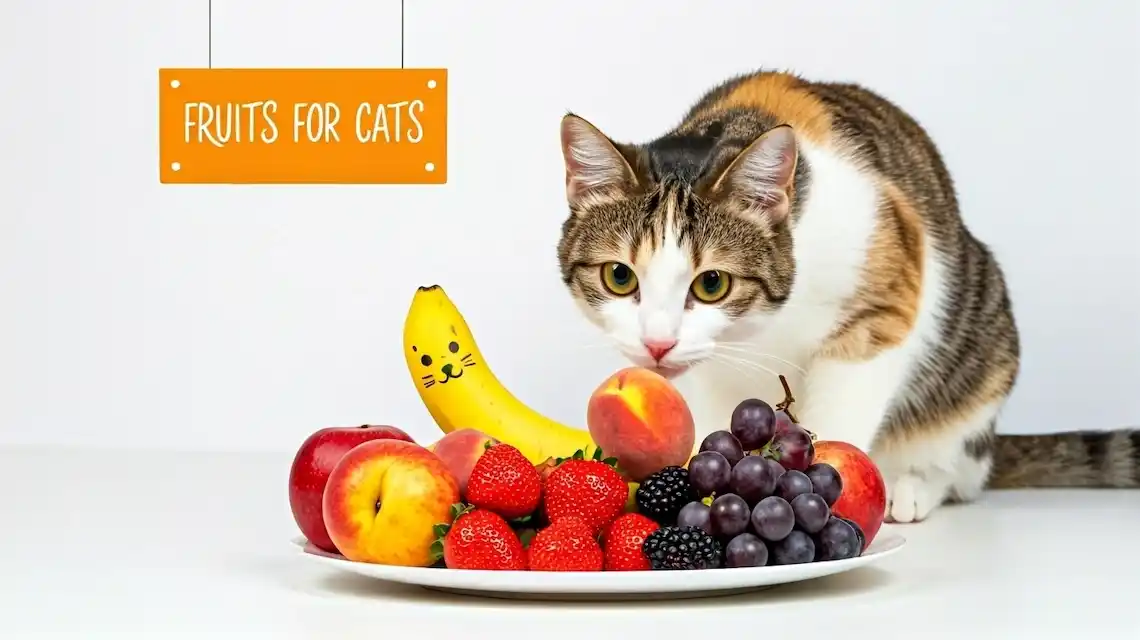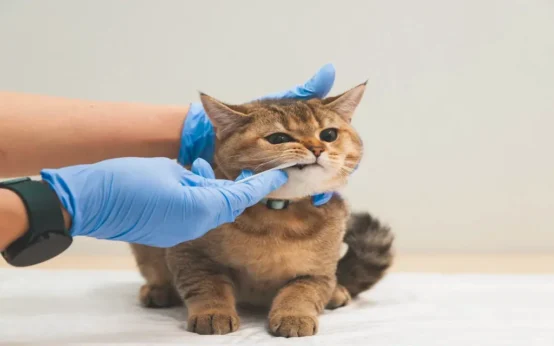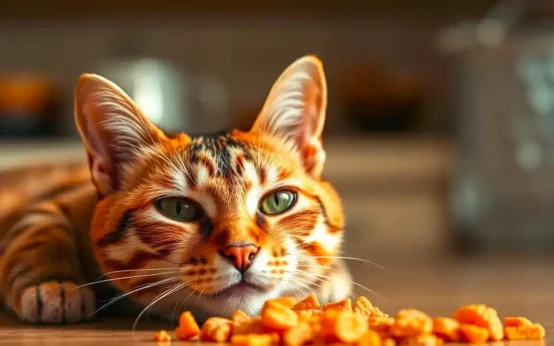Curious cats love to nose around our snacks, and fruit often steals their attention. If you’re asking what fruits can cats eat, the short answer is a few, in small amounts. Think tiny tastes of apple (no seeds), banana, blueberry, strawberry, and seedless watermelon. Some cats like cucumber or cantaloupe too.
Why fruit at all? The juicy texture and sweet smell can spark interest, even though cats are obligate carnivores. Fruit should be a rare treat, not a meal. Too much sugar or fiber can upset a cat’s stomach.
Safety comes first. Always wash, peel when needed, remove seeds, pits, cores, and rinds. Cut fruit into tiny pieces to prevent choking. Start with one small bite and watch for vomiting, diarrhea, or itching.
In this guide, you’ll get a clear list of safe fruits and how to serve them. You’ll also see which fruits to avoid, like grapes and raisins, plus citrus and anything with pits or seeds. Then we’ll cover smart feeding tips, from portion sizes to how often to offer a taste.
By the end, you’ll know exactly what to share and what to skip. Your cat gets a fun, safe treat, and you get peace of mind. Ready to learn the safe picks, the no-gos, and simple steps for stress-free feeding?
Safe Fruits Your Cat Can Eat in Moderation
If you are asking what fruits can cats eat, the short list is simple. A few bites of the right fruits can be safe and even helpful. Think hydration, a bit of fiber, and a fun texture. Keep servings tiny, since cats are meat eaters first.
Follow a few basics every time:
- Remove seeds, pits, cores, rinds, and tough skins.
- Cut fruit into pea-size pieces to prevent choking.
- Offer 1 to 2 teaspoons total, once or twice a week at most.
Apples: A Crunchy Treat for Kitty
Peel the apple, slice it thin, and remove the core and all seeds. Apple seeds contain compounds that are unsafe for cats. The flesh has gentle fiber that can help stool quality.
Serve a few small slices, chopped into tiny bits. Apple has natural sugar, so keep it rare. A taste is enough.
- Prep: peeled, no seeds or core, finely chopped.
- Portion: 2 to 4 pea-size pieces.
- Benefit: light fiber; pleasant crunch.
- Caution: sugar content; skip if your cat has diabetes.
Bananas: Potassium Boost Without the Peel
Mash a small piece of ripe banana into a soft paste. You can also offer a pea-size chunk. Skip the peel, since it is tough and not digestible.
Banana is low in fat and easy to offer as a soft treat. Watch for any signs of allergy, like itching or vomiting, when trying a new fruit.
- Prep: peeled, mashed or tiny chunk.
- Portion: 1 to 2 pea-size bites.
- Benefit: potassium and quick energy.
- Caution: Sticky texture can linger on teeth, so keep servings small.
Blueberries: Antioxidant-Rich Berries
Offer fresh or frozen blueberries, whole or halved for smaller mouths. Many cats enjoy batting them around before eating. Antioxidants may support overall health, including a healthy urinary tract, when part of a balanced diet.
Start slowly, since too many berries can cause loose stool.
- Prep: rinsed, fresh or thawed, whole or halved.
- Portion: 1 to 3 berries.
- Benefit: antioxidants and a little fiber.
- Caution: Too many can upset the stomach.
Watermelon: Hydrating Summer Snack
Remove all seeds and the rind, then cut the red flesh into tiny cubes. Watermelon is mostly water, which helps with hydration, especially in warm weather.
Serve a few small chunks as a refreshing treat from the fridge.
- Prep: seedless, rind removed, diced.
- Portion: 2 to 4 tiny cubes.
- Benefit: high water content for hydration.
- Caution: Natural sugars add up if you overdo it.
Strawberries: Sweet and Safe in Small Bites
Wash well, remove the green top, and chop into tiny pieces. Strawberries offer vitamin C and some fiber, but cats do not need extra sugar.
Make it an occasional treat, not a daily snack.
- Prep: washed, hulled, finely chopped.
- Portion: 1 to 2 small pieces.
- Benefit: vitamin C and flavor variety.
- Caution: Natural sugars; monitor for soft stool.
Dangerous Fruits Cats Should Never Eat
When you ask what fruits can cats eat, it helps to know the hard no list. Some fruits are not just a bad idea, they are dangerous. Even a lick or two can trigger vomiting, diarrhea, or worse. Keep these out of reach, no exceptions.
Grapes and Raisins: A Hidden Toxin Risk
Grapes and raisins can cause sudden kidney failure in cats. The reaction is unpredictable, and there is no safe amount. A single grape or a few raisins may be enough.
- Risk: acute kidney damage
- Signs: vomiting, lethargy, no appetite, belly pain, less urine
- Action: avoid completely and call your vet if your cat eats any
There are no safe exceptions. Do not offer grape-flavored snacks or baked goods with raisins.
Citrus Fruits: Too Acidic for Feline Friends
Oranges, lemons, limes, grapefruits, and tangerines are too acidic for cats. The peels, leaves, and seeds contain essential oils and psoralens that irritate the gut.
- Risk: stomach upset and drooling
- Signs: vomiting, diarrhea, trembling if large amounts are eaten
- Action: keep all citrus and peels away from curious paws
Even the smell of citrus oils can bother sensitive cats. Skip citrus-flavored waters and candies too.
Avocados: Creamy but Harmful
Avocados contain persin, a natural toxin found in the leaves, skin, pit, and flesh. Cats are more resistant than birds, but trouble can still happen.
- Risk: vomiting and diarrhea, with heart and lung issues in some animals
- Signs: GI upset, weakness, trouble breathing in severe cases
- Action: do not share avocado in any form, including guacamole
The pit is also a choking hazard. Dispose of scraps where pets cannot reach them.
Cherries: Pits Pose Choking and Poison Dangers
Cherry pits, stems, and leaves contain cyanide compounds. The pits can also block the gut or crack teeth.
- Risk: cyanide poisoning and choking
- Signs: red gums, trouble breathing, dilated pupils, shock
- Action: avoid cherries entirely
Some owners ask about the flesh only. The safest choice is to skip cherries, even in tiny amounts.
Tips for Safely Introducing Fruits to Your Cat’s Diet
Fruits can fit into a balanced cat diet as rare, tiny treats. If you are asking what fruits can cats eat, the safest path is slow, measured, and mindful. Keep your cat’s main calories from complete cat food, then use fruit as a small bonus for enrichment.
Portion Control and Frequency Guidelines
Start small and watch closely. Your cat does not need much.
- Keep treats under 10% of daily calories. That includes fruit and other snacks.
- Begin with a pea-size piece of a single fruit. Wait 24 to 48 hours.
- If no issues appear, offer 1 to 2 teaspoons total, once or twice a week.
- Skip fruit if your cat has diabetes, GI disease, or is on a strict diet. Ask your vet first.
A simple rule: less is safer. Cats are meat eaters, so fruit is optional.
Preparation Steps to Keep It Safe
Clean prep reduces germs, choke risks, and sugar overload.
- Wash thoroughly. Rinse under running water to remove dirt and residues.
- Remove hazards. Take out seeds, pits, cores, rinds, stems, and tough skins.
- Cut tiny. Aim for pea-size pieces, or mash soft fruits for easy licking.
- Serve fresh. Choose fresh or frozen fruit without syrups. Avoid canned fruit packed in sugar.
- Offer fruit plain. No salt, spices, sweeteners, or dairy toppers.
Example: for apple, peel it, remove the core and all seeds, then dice very small.
Watching for Allergic Reactions or Upset
Even safe fruits can bother some cats. Monitor after every new fruit.
Watch for:
- Vomiting or diarrhea
- Gas, bloating, or soft stool
- Itching, face rubbing, or red skin
- Lethargy, hiding, or loss of appetite
Stop the fruit if you see any of these. Call your vet if symptoms are severe, last longer than a day, or your cat has a health condition. For seniors, kittens, and cats on medication, check with your vet before trying new foods. Safe fruit feeding starts with careful portions, clean prep, and close observation.
Conclusion
When friends ask what fruits can cats eat, the answer stays simple and careful. Safe choices include tiny tastes of apple without seeds, banana, blueberry, strawberry, and seedless watermelon. Some cats also enjoy a small bite of cucumber or cantaloupe. Keep portions tiny, serve plain, and watch for any signs of stomach upset.
Skip the risky stuff every time. Grapes and raisins can harm the kidneys. Citrus can irritate the gut. Avocado and cherries bring toxin and choking risks. Pits, seeds, rinds, and peels never belong in a cat bowl.
Your cat’s main diet should be a complete, vet-approved food. Fruit is a rare extra, not a daily snack. If your cat has diabetes, GI issues, or is on medication, talk with your vet before offering any treat.
Want more peace of mind? Start with one pea-size bite, then wait a day. No signs of trouble means you can offer a small taste again later.
Related post:Can a Dog Eat Cat Food?
FAQ: What Fruits Can Cats Eat?
Can cats eat fruit at all?
Yes, in tiny amounts. Cats are obligate carnivores, so fruit is a treat, not a need. Keep all treats under 10 percent of daily calories.
Which fruits are safest for cats?
Good options include blueberries, strawberries, bananas, cantaloupe, honeydew, seedless watermelon, peeled apples without seeds, pears without seeds, mango without pit, pineapple without core or skin, and papaya without seeds. Offer small pieces only.
Are grapes or raisins safe?
No. Grapes and raisins can cause kidney failure in cats. Avoid them completely.
What about cherries, peaches, or apricots?
You can offer a tiny piece of ripe flesh only. Remove pits, stems, and leaves, since they contain cyanide. Pits also pose a choking risk.
Can cats eat apples?
Yes, in small pieces. Remove the core and all seeds. The seeds contain cyanide.
Is banana a good choice?
Yes, a thin slice once in a while is fine. It is high in sugar and potassium, so avoid for cats with diabetes or kidney disease unless your vet approves.
Are citrus fruits OK?
No. Oranges, lemons, limes, and grapefruit can upset the stomach. Oils in the peel can be irritating or toxic.
Can cats eat watermelon?
Yes, if it is seedless and rind removed. Offer small cubes only.
Are blueberries and strawberries safe?
Yes. They are common cat-safe fruits. Rinse well, then offer one or two small pieces.
Is pineapple or mango safe?
Yes, in tiny amounts. Remove skin and core from pineapple. Remove pit and skin from mango. Both are high in sugar.
What about avocado?
Best to avoid it. Cats are less sensitive to persin than birds, but the fat can cause stomach upset, and the pit and skin are unsafe.
Is star fruit toxic to cats?
Yes. Star fruit can cause serious kidney issues. Do not offer it.
Can cats have tomatoes?
Avoid them. Green parts are toxic, and ripe tomatoes can still cause stomach upset.
Is coconut safe?
Coconut flesh in tiny amounts is usually tolerated, but it is high in fat. Coconut water and milk can cause diarrhea. When in doubt, skip it.
Can cats eat pumpkin?
Plain cooked pumpkin, not pie filling, can help with fiber. Offer 1 teaspoon for most cats. Pumpkin is a fruit by botany, but treat it like a supplement, not a snack.
Are dried fruits okay?
No. Dried fruits are sugary, sticky, and pose a choking risk. Raisins are toxic.
Can I give my cat fruit juice or smoothies?
No. They are high in sugar and acid, and may contain xylitol or dairy. Stick to water.
How much fruit is safe to serve?
Think tiny. One or two pea-size pieces, once or twice a week. Use less for small cats or if your cat has stomach issues.
How should I prepare fruit for my cat?
Wash well, remove seeds, pits, stems, leaves, rinds, and tough peels. Cut into small, soft pieces. Serve plain, with no salt, sugar, or spices.
Are there health benefits to fruit for cats?
Not much. Cats do not need fruit for vitamins. A small amount can add flavor or fiber, but meat-based food should do the heavy lifting.
Which cats should avoid fruit?
Skip fruit for cats with diabetes, obesity, pancreatitis, or chronic stomach problems. Ask your vet if your cat has kidney, heart disease or get heartworms, since some fruits are high in potassium.
What signs mean the fruit did not agree with my cat?
Watch for vomiting, diarrhea, drooling, belly pain, or lethargy. If you see these, stop the treat and call your vet. For poisoning concerns, contact ASPCA Animal Poison Control at 888-426-4435.
Any final tips for safe fruit treats?
Introduce one fruit at a time, start small, and watch your cat for 24 hours. Avoid canned fruit in syrup. Never use fruit-flavored candies or yogurt drops. When unsure, skip it or ask your vet.



 Dog Trick Training for Beginners
Dog Trick Training for Beginners  Gingivitis Cats Symptoms Every Pet Parent Should Know
Gingivitis Cats Symptoms Every Pet Parent Should Know  How to Make Dog Cookies at Home
How to Make Dog Cookies at Home  Wet Food or Dry Food for Cats?
Wet Food or Dry Food for Cats?  What Is the Healthiest Hamster Breed for Your Home?
What Is the Healthiest Hamster Breed for Your Home?  Cat Food Intolerance Symptoms: How To Spot Them Early
Cat Food Intolerance Symptoms: How To Spot Them Early